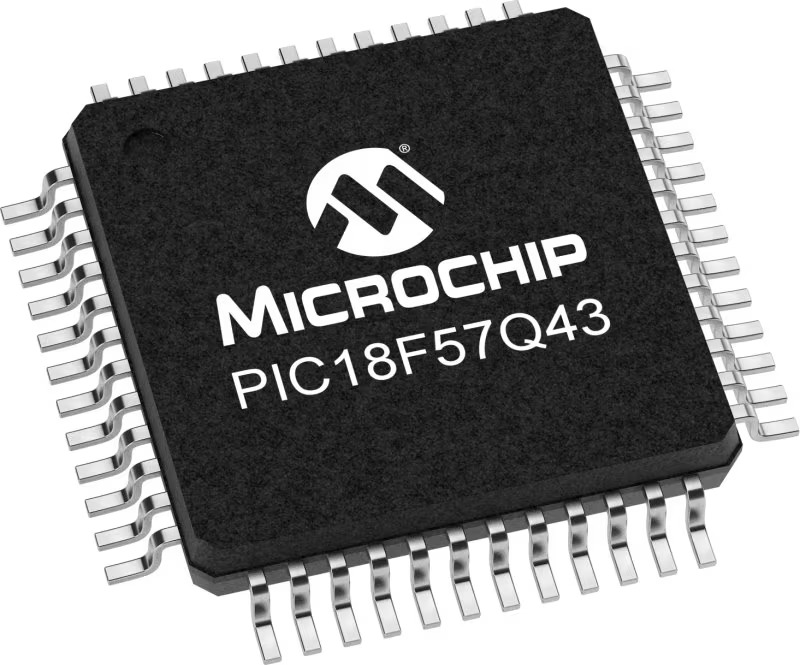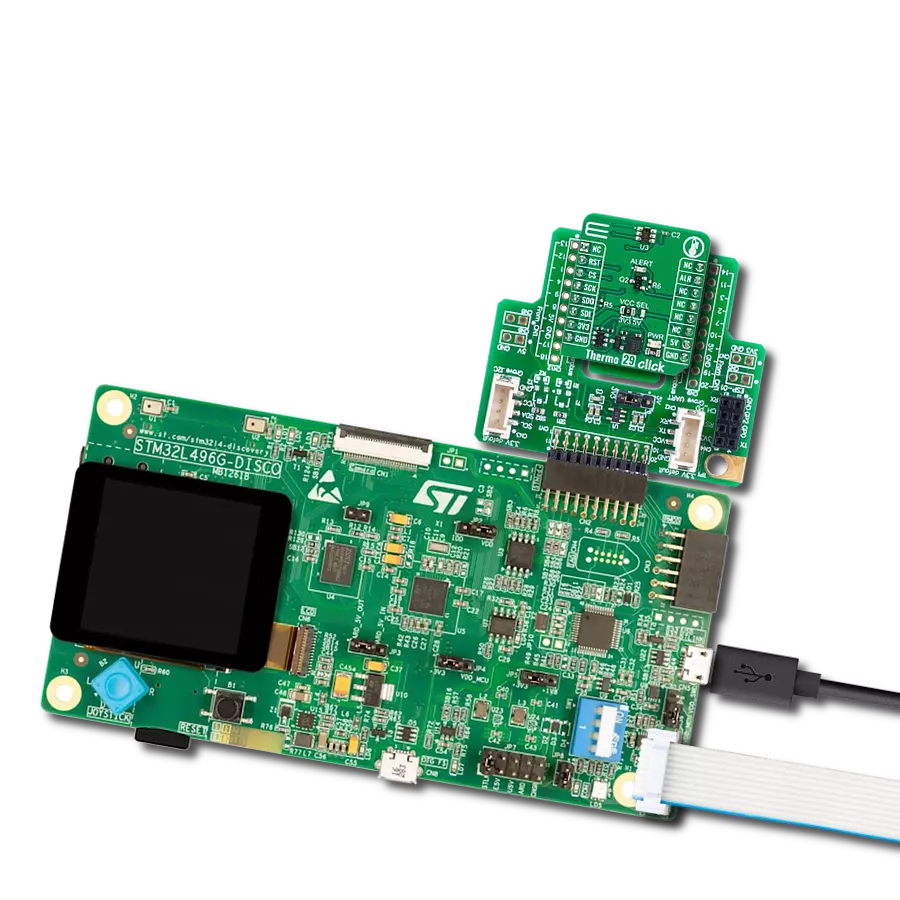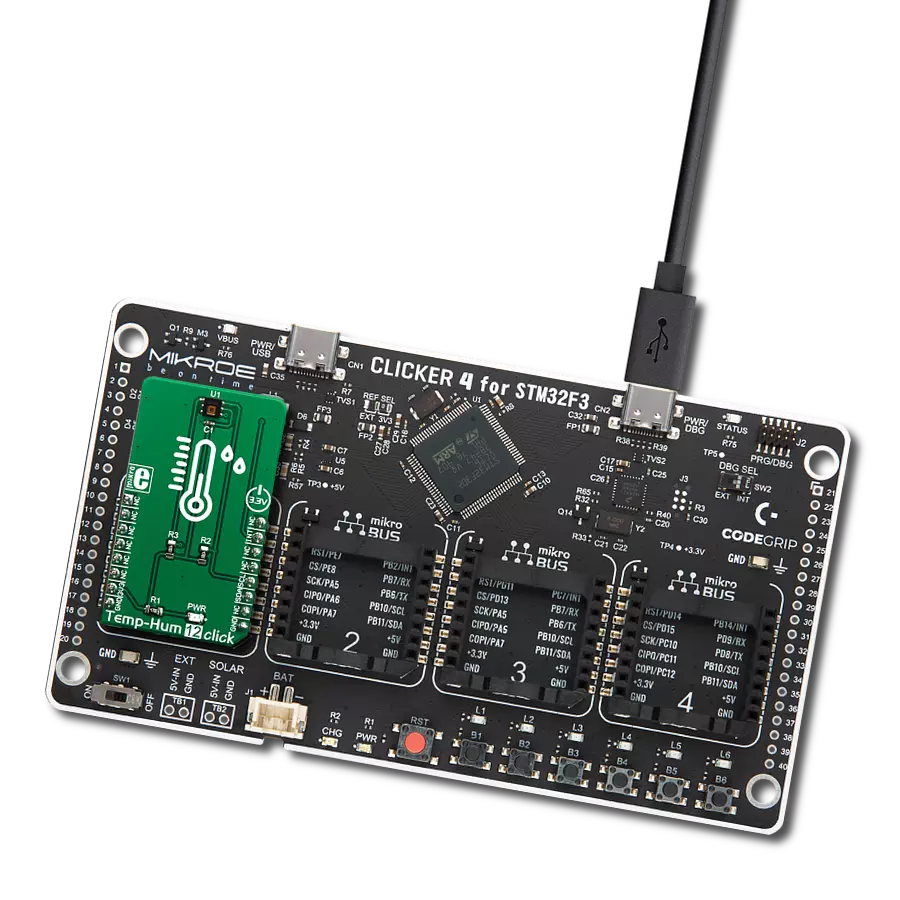Experience the power of contactless temperature monitoring for swift, accurate, and reliable results!
A
A
Hardware Overview
How does it work?
IrThermo 2 Click is based on the TMP007, an infrared thermopile sensor with an integrated Math Engine from Texas Instruments. When there is infrared radiation, and the sensor absorbs it, the integrated Math Engine calculates its temperature by comparing it with the temperature of the silicon die. The sensor is factory calibrated, but the user can adjust the calibration coefficients for specific applications. This adjustment could be the correction for the range, field of view, object shape, and environmental factors. Besides the direct
reading of the object temperature, Math Engine features programmable alerts, nonvolatile memory (EEPROM) for storing calibration coefficients, and transient correction. The IrThermo 2 Click uses an industry-standard I2C interface to communicate with the host MCU over the mikroBUS™ socket. One of eight programmable I2C addresses can be set over the ADR1 and ADR0 solder jumpers labeled ADDR SEL and positions 1 and 0. Those jumpers are set to 0 (GND) by default. It also features an active LOW
alert output on pin AL that can be used as an alert function if the TMP007 is working in an interrupt mode. This Click board™ can operate with either 3.3V or 5V logic voltage levels selected via an onboard jumper. This way, both 3.3V and 5V capable MCUs can use the communication lines properly. However, the Click board™ comes equipped with a library containing easy-to-use functions and an example code that can be used, as a reference, for further development.
Features overview
Development board
PIC18F57Q43 Curiosity Nano evaluation kit is a cutting-edge hardware platform designed to evaluate microcontrollers within the PIC18-Q43 family. Central to its design is the inclusion of the powerful PIC18F57Q43 microcontroller (MCU), offering advanced functionalities and robust performance. Key features of this evaluation kit include a yellow user LED and a responsive
mechanical user switch, providing seamless interaction and testing. The provision for a 32.768kHz crystal footprint ensures precision timing capabilities. With an onboard debugger boasting a green power and status LED, programming and debugging become intuitive and efficient. Further enhancing its utility is the Virtual serial port (CDC) and a debug GPIO channel (DGI
GPIO), offering extensive connectivity options. Powered via USB, this kit boasts an adjustable target voltage feature facilitated by the MIC5353 LDO regulator, ensuring stable operation with an output voltage ranging from 1.8V to 5.1V, with a maximum output current of 500mA, subject to ambient temperature and voltage constraints.
Microcontroller Overview
MCU Card / MCU

Architecture
PIC
MCU Memory (KB)
128
Silicon Vendor
Microchip
Pin count
48
RAM (Bytes)
8196
You complete me!
Accessories
Curiosity Nano Base for Click boards is a versatile hardware extension platform created to streamline the integration between Curiosity Nano kits and extension boards, tailored explicitly for the mikroBUS™-standardized Click boards and Xplained Pro extension boards. This innovative base board (shield) offers seamless connectivity and expansion possibilities, simplifying experimentation and development. Key features include USB power compatibility from the Curiosity Nano kit, alongside an alternative external power input option for enhanced flexibility. The onboard Li-Ion/LiPo charger and management circuit ensure smooth operation for battery-powered applications, simplifying usage and management. Moreover, the base incorporates a fixed 3.3V PSU dedicated to target and mikroBUS™ power rails, alongside a fixed 5.0V boost converter catering to 5V power rails of mikroBUS™ sockets, providing stable power delivery for various connected devices.
Used MCU Pins
mikroBUS™ mapper
Take a closer look
Click board™ Schematic

Step by step
Project assembly
Track your results in real time
Application Output
1. Application Output - In Debug mode, the 'Application Output' window enables real-time data monitoring, offering direct insight into execution results. Ensure proper data display by configuring the environment correctly using the provided tutorial.

2. UART Terminal - Use the UART Terminal to monitor data transmission via a USB to UART converter, allowing direct communication between the Click board™ and your development system. Configure the baud rate and other serial settings according to your project's requirements to ensure proper functionality. For step-by-step setup instructions, refer to the provided tutorial.

3. Plot Output - The Plot feature offers a powerful way to visualize real-time sensor data, enabling trend analysis, debugging, and comparison of multiple data points. To set it up correctly, follow the provided tutorial, which includes a step-by-step example of using the Plot feature to display Click board™ readings. To use the Plot feature in your code, use the function: plot(*insert_graph_name*, variable_name);. This is a general format, and it is up to the user to replace 'insert_graph_name' with the actual graph name and 'variable_name' with the parameter to be displayed.

Software Support
Library Description
This library contains API for IrThermo 2 Click driver.
Key functions:
irthermo2_get_raw_temperature- Function read 16-bit data from raw temperature register and calculate temperature in degrees Celsiusirthermo2_get_object_temperature_c- Function read 16-bit data from object temperature register and calculate temperature in degrees Celsiusirthermo2_get_object_temperature_f- Function read 16-bit data from object temperature register and calculate temperature in degrees Fahrenheit
Open Source
Code example
The complete application code and a ready-to-use project are available through the NECTO Studio Package Manager for direct installation in the NECTO Studio. The application code can also be found on the MIKROE GitHub account.
/*!
* @file main.c
* @brief IrThermo2 Click example
*
* # Description
* IrThermo 2 is a non-contact temperature measurement Click. The sensor absorbs the infrared
* radiation emitted by the target object (withing the sensor’s field of view) and
* the integrated math engine calculates its temperature by comparing it with the temperature
* of the silicon die. The measurement range of the sensor is between –40°C to 125°C.
*
* The demo application is composed of two sections :
*
* ## Application Init
* Initialization driver enable's - I2C, set default configuration and start write log.
*
* ## Application Task
* This is a example which demonstrates the use of IrThermo 2 Click board.
* Measures the object temperature value from sensor and calculate temperature in degrees Celsius [ C ].
* Results are being sent to the USART Terminal where you can track their changes.
* All data logs on usb uart for aproximetly every 5 sec when the data value changes.
*
*
* @author MikroE Team
*
*/
#include "board.h"
#include "log.h"
#include "irthermo2.h"
static irthermo2_t irthermo2;
static log_t logger;
static float temperature;
void application_init ( void )
{
log_cfg_t log_cfg;
irthermo2_cfg_t cfg;
/**
* Logger initialization.
* Default baud rate: 115200
* Default log level: LOG_LEVEL_DEBUG
* @note If USB_UART_RX and USB_UART_TX
* are defined as HAL_PIN_NC, you will
* need to define them manually for log to work.
* See @b LOG_MAP_USB_UART macro definition for detailed explanation.
*/
LOG_MAP_USB_UART( log_cfg );
log_init( &logger, &log_cfg );
log_info( &logger, "---- Application Init ----" );
// Click initialization.
irthermo2_cfg_setup( &cfg );
IRTHERMO2_MAP_MIKROBUS( cfg, MIKROBUS_1 );
irthermo2_init( &irthermo2, &cfg );
irthermo2_default_cfg( &irthermo2 );
Delay_ms ( 100 );
log_info( &logger, "---- Application Task ----" );
}
void application_task ( void )
{
temperature = irthermo2_get_object_temperature_c( &irthermo2 );
log_printf( &logger, " Temperature : %.2f C\r\n", temperature );
log_printf( &logger, "---------------------------\r\n" );
Delay_ms ( 1000 );
}
int main ( void )
{
/* Do not remove this line or clock might not be set correctly. */
#ifdef PREINIT_SUPPORTED
preinit();
#endif
application_init( );
for ( ; ; )
{
application_task( );
}
return 0;
}
// ------------------------------------------------------------------------ END

































